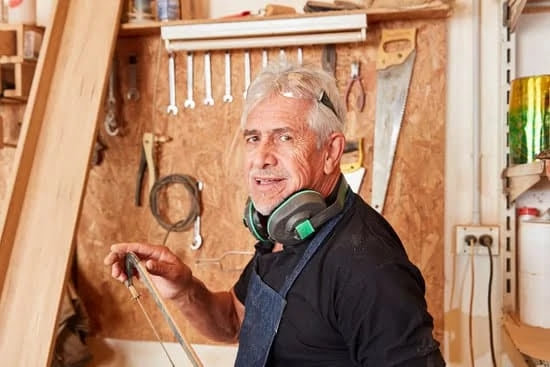Introduction
Woodworking projects are a great way for high schoolers to learn new skills, gain valuable experience, and even earn money. While the process of woodworking may seem intimidating to some, there is no need to worry; with the right tools and products, anyone can become an expert woodworker in no time. Plus, with the many different types of woodworking projects available, high schoolers can create beautiful pieces that will last for years to come.
The benefits of woodworking extend far beyond its educational value. Woodworking projects require creativity and allow individuals to express themselves through their work. Plus, due to the popularity of custom furniture and décor in today’s market, crafting unique pieces can be very lucrative for high schoolers. Finally, woodworkers are essential members of the maker movement ” a social revolution centered around solving problems creatively and finding solutions through collaborative efforts ” which can provide a sense of belonging to those who participate in it.
Woodworking provides high schoolers with opportunities for growth and development that cannot be found elsewhere. As well as boosting academic performance by honing creative problem solving abilities and developing foundational skills such as attention to detail and patience; completing woodworking projects also offers tangible benefits such as being able to build sturdy yet stylish furniture and add unique touches to any interior design space. Moreover, completing these projects allows teens to hone leadership skills since they have the ability produce beautiful work that they are proud of. Additionally, teenagers can acquire practical business knowledge such as building marketing strategies while selling their completed products online or at craft markets or flea markets within their local community”allowing them greater independence when working professionally outside of their home.
Essential Knowledge
High schoolers interested in woodworking projects can create a solid foundation of knowledge and skills by starting with the basics. They should learn how to read woodworking plans, properly measure and cut materials, and use the proper safety equipment such as goggles, gloves, aprons and hearing protection. Students should understand the types of wood they will work with”their hardness, grain patterns, durable properties”and which tools are best suited for particular tasks. Learning even a few basic joinery techniques (e.g., rabbet joints, dovetail joints) will enable students to more easily integrate these essential elements into their projects.
Woodworking projects for high schoolers should aim to develop an overall sense of craftsmanship rooted in principles of accuracy and consistency. It’s equally important for students to visualize the process from start to finish so that they remain organized throughout the build. They should keep careful records of project measurements until completion so that each step lines up correctly with the next”measure twice, cut once! The finer points of sanding and finishing techniques also come into play here to ensure a quality outcome. Finally, teaching students about different types of hardware and techniques for fastening components together can facilitate successful execution as well as a satisfying sense of accomplishment in their progress toward completing a lasting piece of craftsmanship!
What Type of Tools Are Necessary to Tackle a Woodworking Project?
The exact type of tools that are necessary to complete a woodworking project will depend on the project itself. Generally speaking, some basic hand tools such as a hammer, saws (both hand and electric), and chisels are necessary for smaller projects. Larger projects may require the use of larger power tools such as routers, grinders, sanders, planers, lathes, table saws, miter saws and band saws. For school projects more general purpose tools can also be used such as: jigsaws, drill presses/drivers, scrollsaws, and belt sanders. Additionally safety wear should also be considered including eye protection goggles and dust masks or respirators. To ensure safe working conditions gloves are also recommended when handling wood or power equipment. Finally finish sanding supplies like abrasive pads and ease-outs should be considered for all types of projects in order to create a finished look.
Popular Projects
High schoolers looking to engage in some woodworking projects can find plenty of inspiration in the world around them. Here are a few popular project ideas that young makers can explore:
• Creating Shadow Boxes: Young makers can build their own personalized shadow boxes, using pieces of scrap wood, old tin cans, and other small odds and ends to display collections such as coins, movie memorabilia, vintage items, and more.
• Building Birdhouses: Using scrap wood or purchasing pre-cut lumber from a hardware store, high schoolers can craft their own rustic birdhouses from scratch. If desired, paint or stain the house for a finished look. The housing structures can later be placed outdoors for birds to use as well.
• Developing Small Furniture Items: With access to larger pieces of wood such as 2x4s and plywood boards, students can assemble small-scale furniture items like benches, chairs and tables for their gardens or outdoor spaces. This project will require tools such as saws and hammers at the very least to get started.
• Crafting Toolboxes: High schoolers with a knack for organization will love building toolboxes out of quality materials like pine board or birch WoodPlace. They’ll be able to easily personalize them by painting on logos or text designs of choice as they see fit too ” making it an extremely affordable tool storage option
Planning Ahead
Woodworking projects for high schoolers can be an excellent way to develop problem-solving skills and build confidence before college or a career. High schoolers who are new to woodworking may need to start with simpler projects that require fewer tools and skills. Consider introducing them to project-oriented kits, such as birdhouses, a toolbox, stools, benches, shelving units, or small tables. These can provide a great introduction to the practice of woodworking.
Along with providing project-oriented kits, it is also important to review the basics of using saws, drills, sanders and other tools safely. Many high schoolers may not have had much exposure to power tools prior to starting a woodworking project, so safety protocols should be emphasized and any safety equipment made available. It is also important to ensure that students understand how materials used in woodworking must be handled properly in order to avoid accidents or injury due to their inherent hardness and composition.
In terms of planning for larger woodworking projects (such as furniture pieces) with high schoolers, it is essential that thorough instructions from the beginning are laid out so students fully understand the expectations or scope of the task ahead of them. During this phase it is important that proper measurements are taken for each part along with ensuring resources like lumber will be available for the student’s use. Subsequently, during the construction period there should always be demonstrations on each step if applicable; allowing time for individual help if needed; careful observation throughout; regular assessments; and technical assistance when faced with challenging complications coupled with effective problem solving strategies. Finally when everything is said and done there should always be guidelines on how best care for finished products enabling them achieve longevity in their greatest visual forms possible.
Creative Ideas
Woodworking is a great way for high schoolers to explore their creativity. Wood can be used to make a wide variety of items, from useful furniture pieces to decorative art projects.
One fun project for high schoolers is creating signs with custom messages and artwork. A wooden plank can be sanded down, stained, and then have the message or artwork painted onto it. This could range from hanging wall art featuring positive quotes, custom family name signs for the house, or humorous nameplates for bedroom doors. Custom coasters can also be made in similar ways as well as serving trays.
Jewelry boxes are another great woodworking project that require more skill and knowledge of tools like routers, saws, and drills. Sourced lumber or recycled pieces can be turned into personalized jewelry boxes with compartments of all sizes perfect for storing pins, earrings and necklaces in an organized manner. The intricate detail work along with the paint or stain added will result in a piece that becomes a meaningful keepsake for years to come.
Finally, there’s always an opportunity to create furniture pieces like coffee tables, end tables or benches using woodworking skillsets such as edge jointing, sticking tenons and mortise joints ect… The possibilities are truly endless when it comes to working with wood!
Safety First
Woodworking is an enjoyable and rewarding activity for high schoolers, but it is important to follow the necessary safety precautions before getting started. Here are some of the rules and tips to keep in mind while woodworking:
1. Wear protective gear! Whether it being gloves, eyeglasses, ear protection, or a dust mask; safety should never be compromised while working with wood.
2. Be sure you have a clear workspace that is free of clutter, as this helps avoid any tripping hazards. Additionally, make sure that tools are either put away or continually watched to prevent any accidents or loss of items.
3. Make sure to carefully read instructions when using a tool you’ve never used before in order to understand how it works and what safety measures need to be taken with the particular machine. This can save time and potential injury from having to figure out how each tool operates one-by-one as you go along in your project.
4. Store tools safely once work has been completed for the day or between projects; putting away all power tools when not being used and keeping sharp objects out of reach of small children can help protect against potential injury.
5. When sanding wood, minimize dust in the air by wearing safety masks and ensuring proper ventilation of the workspace”this can help reduce the inhalation of wood particles that may irritate airways if breathed in at close range (5-10 feet).
Step-by-Step Guide
Woodworking is a fun and educational activity for high schoolers. With a few tools and materials, students can work on projects to increase their carpentry skills as well as reap the benefits of building something with their own two hands. Before jumping right into the process, here is a step-by-step guide to get started on woodworking projects:
First, secure the necessary safety equipment. Safety glasses, gloves and a dust mask should provide adequate protection while working with any potential hazards.
Second, pick out an appropriate project that utilizes both your skillset and available time. From beginner woodwork to more complicated designs like furniture pieces or musical instruments, there are endless possibilities for projects. Take into consideration the amount of time and supplies needed for each project before selecting one in order to avoid being overwhelmed by the scope of work required.
Third, gather the necessary materials for construction. Common materials include plywood, particle board, glue and stain or finish if desired. Depending on the type of project selected you may need access to additional power tools such as saws or routers if these aren’t already at home (or available through school/local library).
Fourth, draw up plans according to what was determined in Step Two above ” hopefully this would have already been taken care of prior to purchasing supplies! Consider consulting instructional videos or experienced individuals if help is needed getting started or throughout construction process.
Finally, construct your project piece by piece until completion! Don’t be afraid to make mistakes but take notes along the way in case adjustments need to be made in future iterations of your creation. Use extra caution when utilizing any power tools including those borrowed from school/library; these tools can cause catastrophic injury or death if not used properly!
Finding Resources
It can be difficult to find the right tools, materials, and guidance when starting woodworking projects. Fortunately, there are several resources available online and in local communities to help high schoolers with their woodworking projects.
Online resources can provide detailed instructions, videos, images, and other support for those looking to learn about and create a new project. Sites such as YouTube and Instructables have numerous tutorials on a range of different types of projects from basic crafting to more advanced carpentry projects. Most project tutorials on these sites include clear directions as well as images or video that demonstrate each step of the process. Many sites are also accessible from any device which makes it even easier to access detailed plans whenever needed.
In addition to virtual resources, many cities have local community makerspaces where people can come together to work on projects and share tips with one another. These organizations often have workshops offering classes on a variety of topics such as basic carpentry or specific types of woodworking projects. Makerspaces may also provide the tools needed for completing a project at no additional cost. Lastly, most makerspaces will connect their members with professional tradespeople who can offer advice and assistance in creating their own individual works of art.
Wrapping Up
Woodworking projects for high schoolers can be an exciting way to learn more about carpentry, construction and design. Not only do these projects help hone fine motor skills, but they also introduce teenagers to working with tools and different types of materials. Additionally, tackling woodworking projects can be great for socialization, as students work together in groups or pairs to complete larger projects. One of the key benefits of woodworking is the ability to create something tangible and usable from start to finish. Finishing a project can be extremely rewarding, especially when combined with all the knowledge acquired while working on it. The skills learned from completing woodworking tasks are marketable in many industries like construction, furniture making and industrial engineering, which creates even more opportunities for the pupils involved. Lastly, woodworking opens up an array of possibilities for creative expression since it allows teens to work freely during their development process and choose colors, shapes, textures and materials that meet their own aesthetic preferences. With responsibilities can come lots of satisfaction: high schoolers who engage in carpentry skills reap the rewards of having created a product with their own hands that is useful in everyday life!

Hi everyone! I’m a woodworker and blogger, and this is my woodworking blog. In my blog, I share tips and tricks for woodworkers of all skill levels, as well as project ideas that you can try yourself.





